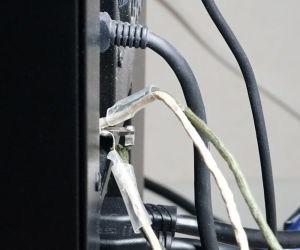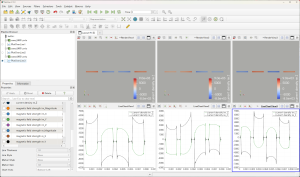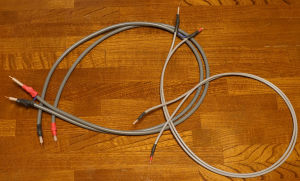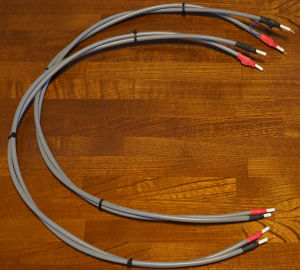PCとデジタルアンプ間用ケーブルを自作しました ― 2022年10月19日 19:35
しかし、送り側のインピーダンスが高いとケーブルの静電容量により受け側で位相遅れが生じる。
定常信号で考えるとは遅れだけなので問題ないが、音楽信号には過渡的な信号が含まれており、位相遅れが立ち上がりのなまりとなり、にぶく聴こえると思われる。
送り側のインピーダンスが低い場合は、送り側の負担が大きくなるだけで、悪影響は小さい。
60Hzのwavファイルを作り、抵抗付きとなしのケーブル端の発生電圧からPCのマザーボード音源の出力インピーダンスを求めたところ200Ωだった。
これでは、音質を優先するとシールドケーブルは使えない。
ツィストペアケーブルのインピーダンスが100~200Ωといわれているので、うまく作れば周波数特性をフラットにできる可能性がある。
何種類か作った結果、基本的に以下のURLリンク先と同じ内容になった。
https://ecaps.exblog.jp/20376547/
(1) 市販のミニプラグ-RCAケーブル
テスターで400~700pF、LCRメーターで250pF、周波数依存性がある。ホット間の静電容量が大きい。にぎやかでぼけている、落ち着きがない。最悪。
(2) RCA変換アダプタ+75Ω同軸
にぎやかさはとれたが、ぼけている。
RCA変換プラグ:10pF~30pFの静電容量、右が20pF程度大きい。
このため、以下のケーブルではミニプラグにツィスト線をハンダ付けして、左右間の静電容量が小さくなるように左右の配線を横出しにした。
(3) LANケーブル
チェンバロ、ピアノ、ギターの音がよくなった。色付けがある。
(4) φ0.4mm PEW線
音がクリアになって、さまざまな音が良く聞こえる。
高音が伸びてチェンバロがきれい。
ギターの弦をはじく音もしっかり聞こえる。
低音も出ている。
(5) φ0.6mm PEW線
音はクリアだが、低音よりになる。
落ち着いた音だがおもしろくない。
レコードプレーヤー用カートリッジ「DL103」風の音。
(6) φ0.4mm PEW線+綿ワックスコード(2.2mm)
落ち着きが出た。音のクリアさエナメル線のまま。Good。これを採用。
ケーブルの静電容量は、20~30pF(1.2m)。
ミニプラグ側の処理が中途半端だが、困っていないので当面はこのまま使用予定。
シールドなしでも、パソコン起動時の高負荷時に高周波数ノイズが入るときがある(影響は配線の位置で変化している模様)程度で、音楽を聴くときは聞こえないので困っていない。
When the connecting cable between devices is analyzed by LTspice, the frequency response is flat if the impedance of the sending side and the impedance of the cable are matched.
However, if the impedance of the sender side is high, a phase delay occurs at the receiver side due to the capacitance of the cable.
This is not a problem when considering a steady signal, since it is only a delay, but a music signal contains transient signals, and the phase delay causes a tepid rise time, which can be heard as a dull sound.
If the impedance of the sender side is low, the burden on the sender side will only increase, and the adverse effect will be small.
I created a 60Hz wav file and calculated the output impedance of the PC motherboard sound source from the voltage generated at the cable end with and without a resistor, and found it to be 200Ω.
This means that a shielded cable cannot be used if sound quality is a priority.
Since the impedance of a twisted pair cable is said to be 100 to 200 Ω, there is a possibility that the frequency response can be flattened if the cable is made well.
As a result of making several kinds of cables, the contents are basically the same as the following URL link.
https://ecaps.exblog.jp/20376547/
(1) Commercially available mini-plug-RCA cable
400-700pF by tester, 250pF by LCR meter, and frequency dependence. Large hot-to-hot capacitance. Lively, blurred, restless. Worst.
(2) RCA conversion adapter + 75Ω coax
Loudness removed, but blurred.
RCA conversion plugs: Capacitance of 10pF to 30pF, the right one is about 20pF larger.
For this reason, in the following cable, twist wires were soldered to the mini-plugs and the left and right wires were wired horizontally to reduce the capacitance between the left and right sides.
(3) LAN cable
Harpsichord, piano, and guitar sound better. Coloring is present.
(4) φ0.4mm PEW wire
Sound became clearer and various sounds could be heard better.
Harpsichord sounds beautiful with extended high notes.
The sound of plucked guitar strings can be heard clearly.
Bass notes are also produced.
(5) φ0.6mm PEW wire
The sound is clear, but more bass-oriented.
The sound is calm but not interesting.
Sound like "DL103" cartridge for record players.
(6) φ0.4mm PEW wire + cotton wax cord (2.2mm)
Sound became calmer. Good.
Capacitance of the cable is 20-30pF (1.2m).
The treatment on the mini-plug side is halfway through, but since we are not having any trouble, we plan to use it as it is for the time being.
Even without shielding, high-frequency noise is sometimes heard at high loads when starting up a PC (the effect seems to vary depending on the wiring position), but not when listening to music, so I am not troubled.
フラット型スピーカーケーブルの電流密度 ― 2022年10月20日 20:19
導体の片端に正負の電圧を加え、反対側を接地しています。
導体抵抗、インダクタンス、表皮効果、近接効果などが複合したときの電流分布となります。
単純に考えて、抵抗性電流(re)が大きい方が良いので、一番右(行き→戻り→行き→戻り)が最も良さそうです。
フラット形状の導体では、近接効果が強く出るようです。
パソコン用スピーカー用ケーブルなど短い場合は、工夫すれば作れる気がします。
ピュアオーディオ用では、ケーブルが長くなるのと要求水準が高くなるので設計が難しそうです(導体を離すとインダクタンスが増えるし、近づけると近接効果が出る)。
Using the Finnish CAE software ElmerFEM, I calculated the current density at 20 kHz for a flat shaped speaker cable.
Positive and negative voltage is applied to one end of the conductor and the other end is grounded.
This is the current distribution when the conductor resistance, inductance, skin effect, and proximity effect are combined.
Simply put, the higher the resistive current (re), the better, so the rightmost (going → returning → going → returning) seems to be the best.
With flat shaped conductors, the proximity effect seems to be stronger.
In the case of short cables, such as speaker cables for PCs, I feel that they can be made with some ingenuity.
For pure audio cables, it seems to be difficult to design because the cables are longer and the requirements are higher (inductance increases when the conductors are separated, and the proximity effect occurs when they are closer to each other).
手持ちの材料でスピーカーケーブルを自作しました ― 2022年10月20日 20:48
デジタルアンプはフルブリッジ回路でスピーカー出力端子(赤黒)の中間がほぼ接地電位になるようです。
(1) 同軸ケーブル(3C-FVR)
編組線に電流を流すと音が悪そうなので、2本用いてφ0.65mmの中心導体で往復させた(シールドに電流を流さないので、磁界はシールドの外に漏れます)。
2本のケーブルのシールドは、スピーカー側で接続し、PVCシースに電圧が加わらないようにした。
試聴結果:
音が明るい気がするが、細かい音まで聴こえる。左右の位相差がよくわかる。
導体を太くすれば、バランスが良くなると思われる。
(2) フラット型スピーカーケーブル
行き、戻り、行き、戻りの2ペア(ElmerFEMの結果から良いと思われる配線方法)。
導体断面積はφ0.8mm相当。
試聴結果:
高音のバランスが良くなったが、音がにじみ位相がはっきりしない。
ぼけて楽器の分離が悪い。
今後は、行き・戻り1ペアのケーブルのみ考えます。
2.5D2V(φ0.8mm) 、S5CFB(φ1.05mm)、5D2V(φ1.4mm)を発注したので、後日のブログで報告します。
I made the following two types of cables and auditioned them from a small speaker from a PC via a digital amplifier.
The digital amplifier seems to be a full bridge circuit and the middle of the speaker output terminals (red and black) are almost at ground potential.
(1) Coaxial cable (3C-FVR)
Since it seems to sound bad if current is applied to the braided wire, two cables were used and reciprocated with a φ0.65mm center conductor (since no current is applied to the shield, the magnetic field leaks out of the shield).
The shields of the two cables were connected at the speaker side so that no voltage is applied to the PVC sheath.
Listening results:.
The sound seems bright, but I can hear every detail. The phase difference between left and right is clearly audible.
The balance would be better if the conductor is thicker.
(2) Flat type speaker cable
Two pairs of cables, one going, one returning, and the other going and returning (wiring method considered good based on ElmerFEM results).
The conductor cross-sectional area is equivalent to φ0.8mm.
Listening results:.
The balance of treble was improved, but the sound was blurred and the phase was not clear.
The sound was blurred and the separation of instruments was poor.
From now on, we will consider only one pair of cables for going and returning.
I have ordered 2.5D2V (φ0.8mm), S5CFB (φ1.05mm), and 5D2V (φ1.4mm) and will report in a later blog.
PC用スピーカーケーブルの自作(50Ω同軸ケーブル編) ― 2022年10月21日 21:39
2本のケーブルのシールドをスピーカー側で接続し、PVCシースに電圧が加わらないようにしています。
ケーブルの線間静電容量は50pF弱です。
今回は、50Ωケーブル同軸ケーブルで自作し(長さ1m)、試聴しました。
絶縁体は、発泡ポリエチレンの方が良いようで、50Ω同軸ケーブルのポリエチレンでは少し色付けを感じました。
なお、小型デジタルアンプ・スピーカーでの試聴結果です。
ピュアオーディオでは、ケーブルが長くなると思われます。
インダクタンスや表皮効果の影響が出やすくなるので、別の評価になる可能性があります。
(1) 2.5D2V(中心導体:φ0.8mm)
3C-FBRと比べて、色付けが感じられた。
中高音のバランスはあまり改善されなかった。
3C-FBRの方が良いように感じました。
(2) 5D2V(中心導体:φ1.4mm)
中高音のバランスが良くなり、音の厚みが出た。
音のクリアさでは3C-FBRの方が上。
どちらを選ぶかは好みで。
S5CFB(中心導体:φ1.05mm、発泡ポリエチレン絶縁)に期待
おまけ(同軸ケーブルを選んだ経緯)
(1) 市販ケーブルの音が悪いことに気づいた
白黒のPVC被覆すずメッキ撚線:最悪
青黒のFEP被覆メッキなし撚線:音がぼけている
これらよりは、φ0.6mmのすずメッキ単線に熱収縮チューブをかぶせて、緩くツイストした方が音が良かった。
単線の方がクリア。
(2) φ0.6mm PEW線(エナメル線)+綿ワックスコード(2.2mm)
音がよりクリアになった。音が明るくなりすぎる。
落ち着きがない。→シースのあるケーブルを使う。
(3) 同軸(3C-FBR)、2本(φ0.65mmの中心導体のみ電流を流す)、2本のシールドを接続(古い在庫を使用)
明るいのは変わらないが、落ち着きが出た。
導体がメッキなしの単線で、絶縁体がポリエチレンやフッ素樹脂のものは、探した範囲ではシース付きのものは同軸ケーブルだった。
絶縁電線なら、47研究所にφ0.4mm、φ0.65mmのものがあります。
As yesterday, two coaxial cables were used, with the signal from the amplifier being carried back and forth on the center conductor.
The shields of the two cables are connected at the speaker end so that no voltage is applied to the PVC sheath.
The line-to-line capacitance of the cable is just under 50 pF.
In this case, I made my own 50-ohm cable coaxial cable (1 m long) and auditioned it.
As for the insulator, polyethylene foam seems to be better, and I felt a little coloration in the polyethylene of the 50-ohm coaxial cable.
Note that the listening results were obtained with a small digital amplifier and speakers.
In pure audio, the cable is expected to be longer.
Since the effects of inductance and skin effect are more likely to appear, it may be evaluated differently.
(1) 2.5D2V (center conductor: φ0.8mm)
Compared to 3C-FBR, coloration was felt.
The balance of mid and high frequencies was not much improved.
3C-FBR seemed to be better.
(2) 5D2V (center conductor: φ1.4mm)
The balance of mid and high frequencies was improved and the sound became thicker.
In terms of sound clarity, 3C-FBR is better.
It is a matter of preference which one to choose.
Expectations for S5CFB (center conductor: φ1.05mm, foamed polyethylene insulation)
Extra (How we chose coaxial cables)
(1) I noticed that commercial cables sounded bad.
Black-and-white PVC-coated tin-plated stranded wire: worst
Blue-black FEP-coated unplated stranded wire: blurred sound
Rather than these, the sound was better with a φ0.6mm tin-plated single wire covered with heat-shrinkable tube and twisted loosely.
Single wire is clearer.
(2) φ0.6mm PEW wire (enameled wire) + cotton wax cord (2.2mm)
Sound became clearer. Sound is too bright.
It is unsettled. →Use a cable with a sheath.
(3) Coaxial (3C-FBR), 2 wires (only φ0.65mm center conductor carries current), 2 shields connected (using old stock)
Still bright, but calmer.
As far as I could find, sheathed coaxial cables with a single wire conductor without plating and polyethylene or fluoroplastic insulation were the ones I looked for.
For insulated wires, 47 Laboratories has φ0.4mm and φ0.65mm ones.
PC用スピーカーケーブルの自作(75Ω同軸ケーブル編) ― 2022年10月22日 18:52
今回は、本命の75Ωケーブル同軸ケーブル(S-5C-FB, 1m, 計4本)で自作し、試聴しました。
ケーブルの特性は、
静電容量:26pF(測定値)、28pF(仕様から計算)
インダクタンス:1.1μH(測定値)、1.07μH(形状から計算)
太さは、5D2Vとほぼ同じですが軽いです。
ケーブルを結束バンドで固定すると、小型アンプへの接続がやりづらいので、接続後に結束するのが良いと思います(あるいは結束しない)。
試聴結果
静電容量が約半分になった影響か、50Ω同軸で感じた色付けは小さく感じました。
中高音のバランスが良くなりました。
目の前で歌う感じです。
ピアノ、リュート、チェンバロの音が良くなった。
奥行が出ます(クラシック音楽では音像が奥の方になります)。
バッハの管弦楽組曲(192kHz/24bitのダウンロード音源)では、PCと小型デジタルアンプの限界を感じました。
このケーブルは、308円/mなので、5m買っても材料費は約1500円です。端部の処置に手間が少しかかります。
https://shop.oyaide.com/products/p-550.html
75Ω同軸ケーブルの仕様
https://www.fujikura-dia.co.jp/pdf/catalog/catalog-trc-cable.pdf
今回の中心導体はφ1.05mmですが、φ0.8mm、φ1.5mmのものがあります。
このケーブルのメリット、デメリットを定性的に考えてみました
メリット
クリアと言われている単線ペアを使用
色付けの少ない無メッキ銅線、低静電容量の発泡ポリエチレン
導体間隔が7.7mmあるので電磁力が小さい
導体が振動しても静電容量やインダクタンスの変化が小さい
近接効果がほとんどない
ケーブルの重量が適度にある
デメリット
インダクタンスが大きい(但し、セパレートアンプでは進み補償のパッシブ回路を付けることで解決できる可能性がある)
表皮効果が聴感上に影響するかどうか微妙
導体が硬く、折れやすい
インダクタンスや表皮効果については、LTspiceやElmerFEMで計算して、後日記載します。
As in the past, two coaxial cables are used for going and returning.
This time, I made my own coaxial cables (S-5C-FB, 1m, 4 cables in total) with 75Ω cables and auditioned them.
The cable characteristics are
Capacitance: 26pF (measured value), 28pF (calculated from specifications)
Inductance: 1.1μH (measured value), 1.07μH (calculated from the shape)
The thickness is almost the same as that of 5D2V, but lighter.
It is better to tie (or not to tie) the cable after connection, because it is difficult to connect to a small amplifier if the cable is fixed with a cable tie.
Listening test results
Perhaps because the capacitance has been reduced by about half, the coloration felt with the 50-ohm coaxial was smaller.
The balance of the mid and high frequencies has improved.
It feels as if it sings in front of my eyes.
Piano, lute, and harpsichord sound better.
Depth is produced (in classical music, the sound image is at the back of the room).
With Bach's orchestral suite (192 kHz/24 bit downloaded source), I felt the limitations of my PC and small digital amplifier.
This cable costs 308 yen/m, so if you buy 5m, the material cost is about 1500 yen. It takes a little time and effort to treat the ends.
https://shop.oyaide.com/products/p-550.html
Specifications of 75 ohm coaxial cable
https://www.fujikura-dia.co.jp/pdf/catalog/catalog-trc-cable.pdf
The center conductor in this case is φ1.05mm, but φ0.8mm and φ1.5mm are available.
I have qualitatively considered the advantages and disadvantages of this cable
Merit
Uses a single wire pair that is said to be clear
Unplated copper wire with little coloration, low capacitance foamed polyethylene
Low electromagnetic force due to 7.7mm conductor spacing
Small change in capacitance and inductance even when conductors vibrate
Almost no proximity effect
Moderate weight of the cable
Demerit
Large inductance (however, this may be solved by adding a passive circuit for advanced compensation in separate amplifiers)
The skin effect may or may not have an audible effect.
Conductors are hard and easily broken.
Inductance and skin effect will be calculated by LTspice and ElmerFEM and described later.





最近のコメント